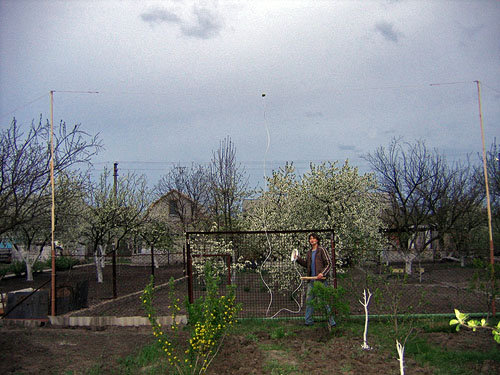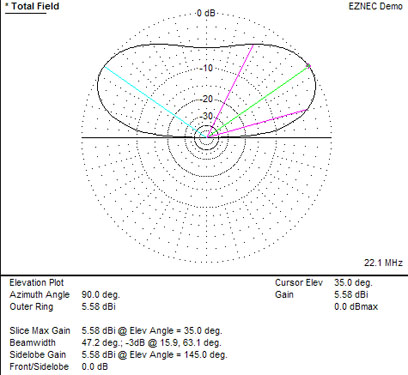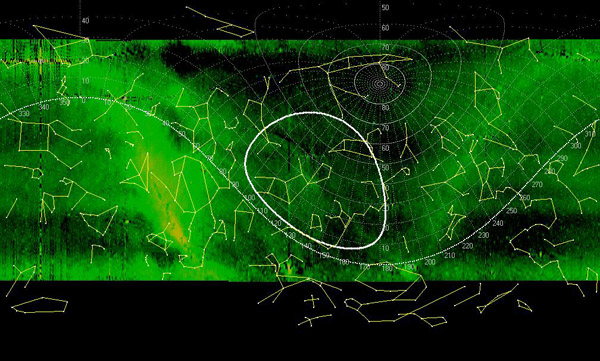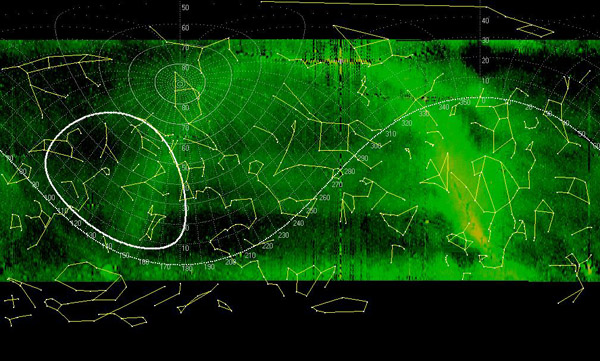

by Maxim Usatov and Nik Korchewski, May 2007
Balovka, Dniepropetrovsk, Ukraine
This is the first trial of a homebrew, very simple radiotelescope we just installed in Balovka.
The goal was to capture the synchrotron emission during the galactic transit, particulary high-temperature regions nearby constellation Saggitarius, a centre of our Milky Way galaxy. The radiotelescope itself is based on AOR AR-3000A receiver, a half wave dipole antenna and a PC with soundcard and Radio Skypipe software. This is how the setup looks with Nik Korchewski standing in front of the antenna as well as antenna properties on the right:


The antenna is made of a 2.5mm copper wire at the height of a 5.5m with each dipole length as 3.55m (total 7.1m wire length). We initially planned 20.1 MHz as the center frequency as per NASA RadioJove project preference, however we later found that this frequency is very polluted with terrestrial interference, thus we picked 22.09 MHz later. Antenna has minor negligible drawbacks due to the minor frequency increase, as shown in the EZNEC diagram above, the max gain is 5.59 dBi ideally. The receiver was set up to listen AM modulation.
The setup has been run for two and a half days recording the data. Unfortunately the AGC has been kept on during the whole session as it is very difficult to turn it off in our AOR. We later plan to implement a different, more simple receiver without AGC if project rolls on. Here is the overview of the data we captured:

The two galactic transits during two nights - approx. 10 hour humps on the chart are easily seen with approximately 3 dB noise floor gain. There are lots of static, interference, powerline buzz and noise from the Sun during the daytime. I would think of moving to a different frequency or using a bandpass filter next time to see if it helps to defeat this. Below is the sky map with antenna beam showing approximate location of the galactic plane and constellations. Images were done with Radio Eyes software which is an incredible help for an amateur radio astronomers like us. A 35 MHz sky map supplied with Radio Eyes is used as the background just for an approximate reference. I have to believe noise sourcess look less focused at lower frequencies.
The top picture is the sky location just before the noise floor increases. The antenna is pointing at Virgo where the sky is moderately cold.

The middle one is the maximum of the transit as per the chart - occured approximately 23:30 UT with Aquila in centre. Noise temperatures increase significantly as these locations are close to Saggitarius (seen at the lower edge of the antenna beam).

The last picture relfects the minimum on the chart, pointing to Cancer and Canis Minor in the centre where sky temperatures are the lowest. Milky Way emits radio waves from these regions, however much weaker than from it's centre - this is below our setup sensitivity and is thus not reflected on the charts.

And here you can listen to a high-pitched (2.5 days resampled into 20 seconds) audio of the whole event - two Milky Way galactic transits through the antenna beam. High levels of noise at the beginning and at the end represents a transit. MP3 Audio - 324 Kb.
These are the links which you may find of interest when implementing a similiar project:
NASA's Radio JOVE Project: Home Page
Radio Astronomy for Scientists Teachers and Students
PHYSICS 728 , RADIO ASTRONOMY
EZNEC Antenna Software by W7EL
The Stanback Planetarium Amateur Radio Astronomy Webpage and WebRing
The Multispectral Sun
NANÇAY Observatory - The Decametric Array
Fringe Dwellers - Simple Radio Interferometry
Special thanks to Richard Flagg and Jim Sky from Radio Sky Publishing for support. :-)
For contacting us via e-mail: maxim.usatov -at- bcsatellite.net and nik.korchewski -at- bcsatellite.net